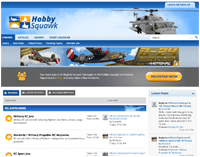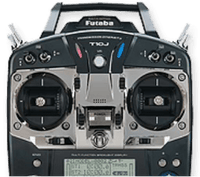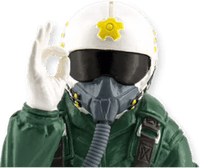Flight School 101 For Beginners
by Todd BredaFlight School 101 For Beginners
If you are reading this article, chances are you or someone you know is looking into learning how to fly R/C models, or perhaps even a full sized airplane. Either way, there are general principles of aerodynamics that apply to both small and full scale aircraft.
So let's dive right in! Since Motion RC is a distributor of R/C aircraft, we will use model aircraft for reference, however like stated previously, the same principles apply to full scale aircraft.
The Forces At Work
In aerodynamics, there are four primary forces at work:
Thrust
Thrust is the force that propels your aircraft forward. Either a propeller or Electric-Ducted Fan utilize blades powered by motors to "push" air towards the back of the aircraft. This creates thrust, or forward motion.
Weight
Weight is the mass of the aircraft. This force is always wanting to pull the aircraft back down to the ground due to the forces of gravity.
Lift
Lift is the force created by the airfoil or camber of the wing that allows an airplane to rise higher into the sky. This force is completely predicated on the amount of thrust the airplane is generating and the ability of the wing's aerodynamic properties to generate lift.
Drag
This is the force that is always working against the aircraft. The opposite of thrust. The more mass that an airplane has, the more drag it will encounter in the air. The more objects air has to move around, the more drag exists. Take for instance a jet that is "clean" (no ordinance/fuel tanks) versus "dirty" (tanks and ordinance). The latter creates more drag due to the various surfaces the air has to move around. Also known as "parasitic drag".
The 3 Axes of Flight
In aerodynamics there are 3 axes that affect the way an airplane flies in three dimensional space.
Pitch
Pitch is the axis that causes the nose of the airplane to rise or fall. The control surface that effects the pitch axis is the elevator, traditionally found on the horizontal portion of the tail of an airplane.
Roll
Roll is the longitudinal axis that allows the wing of an aircraft to rise or fall by banking the wing to one side or the other (one wingtip rises as the opposite wingtip lowers). Ailerons, the control surfaces on the wing, control roll.
Yaw
Yaw is the axis that allows the nose of the aircraft to move left or right. The control surface that controls yaw is the rudder, traditionally found on the vertical portion of the tail of an airplane.
Flaps: Need A Lift?
Flaps are commonly found on the inboard (closest section to the fuselage) trailing edge of a wing. Their primary purpose is increasing the camber (or curvature) of a wing which increases lift. At slower speeds flaps increase lift, which enables the airplane to fly at a greatly reduced speed with a lower risk of stalling. This is especially useful during takeoff and landing. Flaps that are found on the leading edge of a wing are called slats and can be found on many commercial and military jets.
The Controls
There are four primary controls in R/C flight. These controls dictate the model's flyability. Let's take a look at each, and how they effect flight.
Aileron
Using the traditional Mode 2 layout of a R/C transmitter (left stick is for throttle and rudder, right stick is for aileron and elevator control), the ailerons are used (in conjunction with the rudder) to turn or bank the aircraft. The ailerons are controlled on the right stick, toggling between the left and right axis. If you want to turn your model left, you would simply turn the right stick to the left. To turn right, simply turn the stick to the right.
Rudder
The rudder is used to point the aircraft's nose either left or right. For ground operations you simply turn the left stick either left or right (with the throttle) depending on where you want the aircraft to go. When banking/turning in the air, you gently input the rudder stick in the same direction you are turning the aileron stick.
So for a left turn, you would gently turn the right stick to the left and gently turn the left stick to the left at the same time. This is called a "Coordinated Turn" in aviation. It's always a good habit to use the rudder along with the aileron for clean, coordinated turns. Just don't use too much as it doesn't take much input for the rudder to be effective in a turn. Too much rudder could cause the model to go into an uncontrollable spin. Gentle inputs always rule the day in R/C flight.
Elevator
The elevator lifts or lowers the aircraft's nose. With throttle, the elevator will increase or decrease altitude. The elevator is controlled on the right stick, either up or down (pushing the stick away from you or towards you). To increase altitude, you gently pull the stick towards you (down). To decrease altitude you would gently push the stick away from you (up).
Throttle
Throttle is used to increase or decrease your aircraft's airspeed. To increase your model's airspeed (to takeoff for instance) you gently push the left stick away from you, towards the top of the radio. To decrease power or thrust, you simply pull the stick towards you (down).
When you learn to fly, you will use all four controls simultaneously to successfully takeoff, fly and land your model. Successfully flying your aircraft is a wonderfully fulfilling and rewarding experience. If you are ready to get started, our Customer Support team is happy to assist you and get you on the road to success with an appropriate trainer model. Give us a call or chat with us today!
If you like this article and have ideas for others, please feel free to send me an e-mail!
Get the latest from Motion RC sale and product announcements
You can unsubscribe at any time!

Hobby Squawk Community Forum
visit forum
RC Knowledge Blog
visit blog
Guidance & advice for beginners
Find out more- Choosing a selection results in a full page refresh.
- Press the space key then arrow keys to make a selection.
